Imagine discovering traces of a town—photos, postcards, even memorabilia—but no map, no government record, no geographic proof that it ever existed. No one talks about it. No one remembers being there. And yet, for some, Doveland feels eerily familiar.
Welcome to one of the internet’s most perplexing urban legends—the story of Doveland, Wisconsin, a town said to have disappeared without a trace, swallowed by silence, secrecy, or perhaps something far more mysterious. What makes Doveland spine-chilling isn’t just that it’s “gone”—it’s that it might never have officially existed, yet leaves behind just enough breadcrumbs to question everything we think we know about reality, memory, and the reliability of history itself.
The Myth Begins: What Is Doveland?
The first rumblings of Doveland’s existence appeared in the form of cryptic online posts and Reddit threads. Users shared stories of receiving postcards or souvenirs labeled “Greetings from Doveland, Wisconsin.” But when curious minds went searching—nothing came up. No archived maps, no population data, not even a passing mention in newspapers or government records.
According to legend, Doveland was once a small town in Wisconsin that mysteriously ceased to exist in the late 1980s or early 1990s. The reasons behind its disappearance range from government conspiracy and top-secret experiments to mass memory manipulation or alternate dimensions.
What made it more eerie was the collective uncertainty. A few people insisted they’d visited Doveland, while others described vivid childhood memories of road trips or seeing it on signs. But no concrete evidence has ever surfaced—except those strange physical artifacts.
Souvenirs from Nowhere
Adding fuel to the enigma are physical items: Doveland keychains, fridge magnets, mugs, and postcards that occasionally pop up in online marketplaces or antique shops. Often dated, weathered, and aged as if from a long-forgotten era, these artifacts suggest that someone, somewhere, was producing merchandise for a place that supposedly never existed.
Skeptics argue these items are custom-made hoaxes, yet no one has come forward to claim responsibility. Others claim the town’s existence was intentionally erased—wiped from the collective memory in a government operation akin to a “real-world redaction.”
Theories Behind the Vanishing
1. Government Experiment Gone Wrong:
One popular theory suggests Doveland was part of a secret governmental or military project, and after an incident, it was permanently shut down and scrubbed from all records.
2. The Mandela Effect:
Some believe Doveland is part of a mass misremembering caused by parallel timelines or a glitch in the matrix. The Mandela Effect explains why groups of people vividly recall events or places that don’t officially exist.
3. Deliberate Erasure:
Others theorize Doveland might have been sacrificed for a greater cause—perhaps an environmental disaster or a classified accident. The town was allegedly bulldozed, its residents relocated, and its memory deleted under a nondisclosure agreement.
The Legacy of the Forgotten
Today, Doveland sits at the intersection of modern myth and internet legend. Whether it was ever real, partially true, or entirely fabricated, its presence lingers like a phantom in online forums and conspiracy circles. It represents something deeper: our fear that the world isn’t as fixed or factual as we believe. That places, like people, can disappear.
The Final Mystery: Why Does It Haunt Us?
In a world dominated by data and digital footprints, how could an entire town disappear without a trace? And if Doveland truly never existed, why do so many feel like they remember it?
Maybe the most chilling part of the Doveland saga isn’t whether the town was real—but the possibility that we live in a world where it could be erased so easily. Forgotten not just by time, but by force. And maybe, just maybe, somewhere out there, beyond memory and maps, Doveland still exists—waiting to be found.














0 comments:
Post a Comment